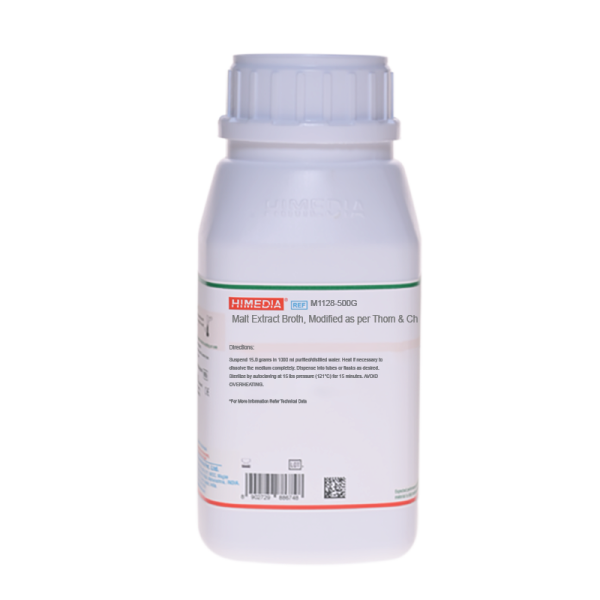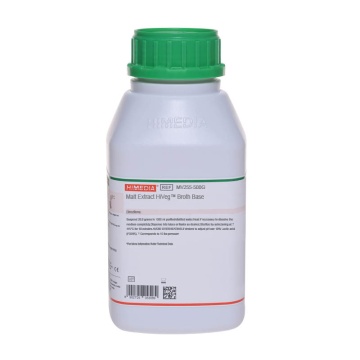 Your enquiry has been submitted
Your enquiry has been submitted
Malt Extract Broth, Modified as per Thom and Church
Intended Use:
Recommended for isolation, detection and enumeration of yeasts and moulds and to check sterility to detect presence of these organisms.
Composition**
| Ingredients | g/L |
|---|---|
| Malt extract | 6.000 |
| Maltose | 1.800 |
| Dextrose (Glucose) | 6.000 |
| Yeast extract | 1.200 |
Final pH (at 25°C): 4.7±0.2
**Formula adjusted, standardized to suit performance parameters
Directions
Suspend 15.0 grams in 1000 ml purified/distilled water. Heat if necessary to dissolve the medium completely. Dispense into tubes or flasks as desired. Sterilize by autoclaving at 15 lbs pressure (121°C) for 15 minutes. AVOID OVERHEATING.
Principle And Interpretation
Malt Extract medium is recommended for the isolation, detection and enumeration of yeasts and moulds. Reddish (1) described a medium prepared from malt extract which was an acceptable substitute for wort. Following the formula of Reddish, Thom and Church (2) used Malt extract as a base from which they prepared the complete media. Malt extract and yeast extract provide essential growth nutrients for the growth of fungi. Maltose and dextrose are the suitable carbohydrates for the growth of fungi. The low pH inhibits bacterial growth (3).
Type of specimen
Clinical samples -skin scrapping, nail scrapping etc.
Specimen Collection and Handling:
Inoculate the specimen directly into tubes of the medium and incubate the tubes. After sufficient incubation observe for the presence of turbidity and subculture on selective and non-selective media for isolation of individual species. Consult appropriate references for information regarding the processing and inoculation of specimens (4). After use, contaminated materials must be sterilized by autoclaving before discarding.
Warning and Precautions
In Vitro diagnostic Use only. For professional use only. Read the label before opening the container. Wear protective gloves/ protective clothing/ eye protection/ face protection. Follow good microbiological lab practices while handling specimens and culture. Standard precautions as per established guidelines should be followed while handling clinical specimens. Safety guidelines may be referred in individual safety data sheets
Limitations
- Individual organisms differ in their growth requirement and may show variable growth patterns on the medium.
- Each lot of the medium has been tested for the organisms specified on the COA. It is recommended to users to validate the medium for any specific microorganism other than mentioned in the COA based on the user's unique requirement.
Performance and Evaluation
Performance of the medium is expected when used as per the direction on the label within the expiry period when stored at recommended temperature.
Quality Control
Appearance Cream to yellow homogeneous free flowing powder
Colour and Clarity of prepared medium Yellow coloured clear to slightly opalescent solution in tubes
Reaction
Reaction of 1.5% w/v aqueous solution at 25°C. pH : 4.7±0.2
pH 4.50-4.90
Cultural Response
Cultural characteristics observed after an incubation at 25 -30°C for 40 - 48 hours.
| Organism | Inoculum (CFU) | Growth |
|---|---|---|
| #Aspergillus brasiliensis ATCC 16404 (00053*) | 50-100 | good - luxuriant |
| Candida albicans ATCC 10231 (00054*) | 50-100 | good - luxuriant |
| Saccharomyces cerevisiae ATCC 9763 (00058*) | 50-100 | good - luxuriant |
Key: (*) Corresponding WDCM numbers, #Formerly known as Aspergillus niger
Storage and Shelf Life
Store between 10-30°C in a tightly closed container and the prepared medium at 2-8°C. Use before expiry date on the label. On opening, product should be properly stored dry, after tightly capping the bottle in order to prevent lump formation due to the hygroscopic nature of the product. Improper storage of the product may lead to lump formation. Store in dry ventilated area protected from extremes of temperature and sources of ignition. Seal the container tightly after use. Product performance is best if used within stated expiry period.
Disposal
User must ensure safe disposal by autoclaving and/or incineration of used or unusable preparations of this product. Follow established laboratory procedures in disposing of infectious materials and material that comes into contact with clinical sample must be decontaminated and disposed of in accordance with current laboratory techniques (5,6).
Reference
- Reddish, 1919, Abst. Bact., 3:6.
- Thom and Church, 1926, The Aspergilli.
- Lennett, Balows, Hausler and Shadomy (Eds.), 1985, Manual of Clinical Microbiology, 4th ed., ASM, Washington, D.C.
- Ajello L., Georg L. K., Kaplan W. and Kaufman L., 1963, CDC Laboratory Manual for Medical Mycology, Washington, D. C.
- Isenberg, H.D. Clinical Microbiology Procedures Handbook 2nd Edition.
- Jorgensen, J.H., Pfaller, M.A., Carroll, K.C., Funke, G., Landry, M.L., Richter, S.S and Warnock., D.W. (2015) Manual of Clinical Microbiology, 11th Edition. Vol. 1.
| Product Name | Malt Extract Broth, Modified as per Thom and Church |
|---|---|
| SKU | M1128 |
| Product Type | Regular |
| Physical Form | Powder |
| Origin | Animal Free (Veg) |
| Packaging type | HDPE |
| References | 1. Reddish, 1919, Abst. Bact., 3:6. |
| Customized Product Available | No |









